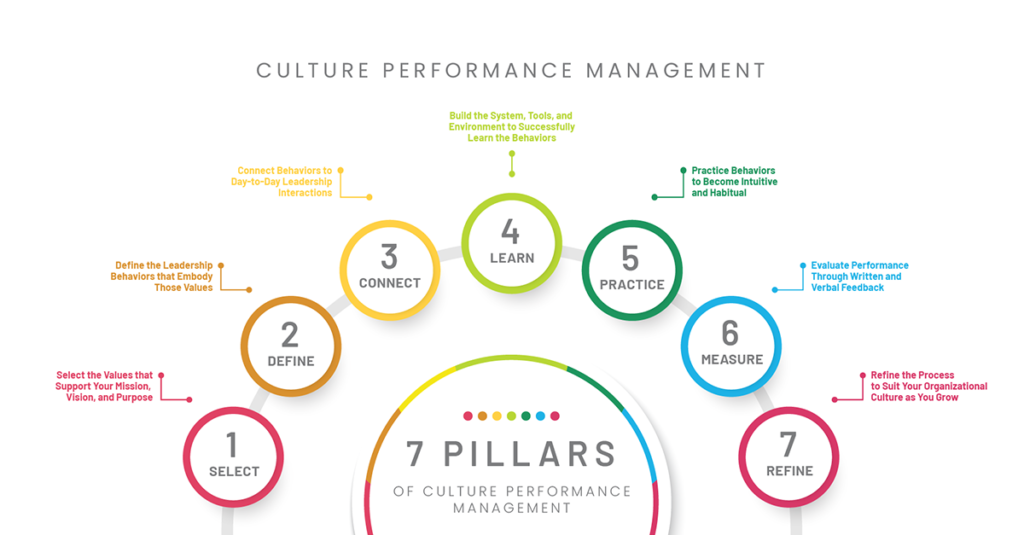
CPM is built on seven essential elements, or pillars, that act like a building’s foundation. These seven pillars, when implemented purposefully and diligently, form a cycle of continuous improvement.
In part one of our three-part CPM series, we defined Culture Performance Management. To briefly recap, CPM gives you the ability to measure the performance of your leadership and workforce, not just against daily operations KPIs but at their cultural connectedness level. In other words, how your leadership connects with and embodies your core values. Do they “walk the walk,” so to speak? By examining and measuring how leadership embodies your core values, you can begin to manage and improve your culture.
For example, if “trust” is a value your company desires to engender, your leaders can exhibit specific and trainable behaviors to be “trustworthy,” such as fairness and consistency in their daily dealings with people. Training a leader on being consistent and fair in their interactions improves their trustworthiness and reinforces one of your core values.
To put it simply, Culture Performance Management helps you take the often-abstract values and well-intentioned corporate culture statements and convert them directly into trainable and, therefore, measurable, manageable, and sustainable behaviors. That’s again why Culture Performance Management begins at the top.
In this article, we’ll look at how Culture Performance Management works. CPM is built on seven essential elements, or pillars, that act like a building’s foundation. These seven pillars, when implemented purposefully and diligently, form a cycle of continuous culture improvement. And that, of course, is the goal: optimization and continuous improvement applied to organizational culture.
The Seven Pillars of Culture Performance Management are Select, Define, Connect, Learn, Practice, Measure, and Refine
1. Select
The first pillar is Select, which refers to your organization’s identification and selection of the core values, or guiding principles, that bind your organization’s stakeholders together in common purpose in business. To be successful, CPM requires this foundational set of values that all employees are expected to embody when interacting with others and making decisions that impact the business.
The value selection process can begin by examining and assessing the values already present and fulfill your mission, vision, and purpose. If your company doesn’t have specific values selected, this is an ideal opportunity to build them. The objective at this step is to have a broad set of values that support your desired culture.
2. Define
In the Define step, you must work to underpin your core values from more generalized language and concepts with the actual daily leadership attitudes and behaviors that embody those values. The idea is to make these values real and practical, able to be learned, demonstrated, and refined by your leaders and then across your workforce.
We begin the Define part of our CPM process by studying your leaders’ daily activities and encounters. Do they exhibit the skills and behaviors that embody your values and drive positive cultural and operational performance? The result is a real awareness or consciousness of the state of your culture. We find that of the 80 percent of businesses that have a stated value system in place, only 30 percent have gone on to define the behavioral expectations that foster ownership and accountability to them.
3. Connect
The Connect pillar takes the leadership attributes and behaviors defined previously and connects them at the front line of your organization. These “Cultural Connections” are the moments when your frontline leaders could exhibit the behaviors that support the culture you are trying to build. We find that the organization’s desired culture breaks down or erodes in these often-momentary interactions.
These daily contact points are where the rubber meets the road, so to speak, of your desired culture versus your actual culture. The day-to-day firefighting and other challenges your frontline leaders encounter can push the correct behaviors away from their minds. The opportunity lies in observing and assessing these gaps between the actual state and ideal state, these cultural connection points, and building training to improve them.
4. Learn
Now that you’ve selected your values, defined the behaviors that support them, and connected them to daily interactions at the front line, the next step is to Learn. It’s one thing to mimic a behavior briefly, in front of upper management, for example, but it’s another to have true competency. The objective in the Learn pillar is true “Cultural Competence,” defined in Dr. Donte Vaughn and Randall Powers’ book on CPM as “an organization’s ability to consistently and effectively manifest behaviors that exemplify its company culture.”
Like anything you want to do well, to achieve competence, then mastery takes training. Building the learning system that will reach and engage your leaders and workforce to achieve Cultural Competence is a significant undertaking, but it is the only way to create an authentic culture that’s continuously improving.
5. Practice
Now it’s time to put the learning into Practice, our fifth pillar of CPM. Practice is about your leader’s applied understanding of what, when, why, and how the behaviors that embody your values impact how they work with others and make decisions daily. When behavioral expectations and standards for engagement, those attributes you’ve defined as the very fiber of your desired company culture, are practiced, they become intuitive and habitual.
Too often, leaders are promoted up through the ranks based on their technical prowess on a specific task. They don’t possess the skills to manage others. They just know a particular job or process better than anyone else. By putting the system in place to learn and practice the behaviors that embody your desired culture, you’ll empower your frontline leaders for success, an investment that will help attract and retain talented people.
6. Measure
Pillar six, Measure, promotes the evaluation and validation that your leaders are exhibiting the expected behaviors and engagement standards and identifies any gaps or areas for improvement. Not all your leaders will behave in 100 percent accordance with your desired behaviors and values 100 percent of the time.
The variance helps you establish a control point or “Cultural Centerline” to measure and track those behaviors that fall outside an acceptable range. If a leader’s evaluation falls too far outside the centerline, something has shifted in their attitudes, beliefs, or behavior and presents an opportunity to be examined, understood, and addressed.
7. Refine
The final pillar is to Refine the entire process and set it up for sustainability and success. This step never ends and involves fine tuning and honing the Culture Performance Management system to fit your organization and its ideal cultural state like a glove. The process to Refine requires answering two important questions.
First, how will your organization support your leaders in their development and success? Do they have the tools they need to continue developing? Second, how do you focus on progressing and improving your culture over the long haul, instead of making it a one-time score? In other words, improving culture is the long game. There may be short-term wins to celebrate, but your company culture requires consistent attention and investment over the long haul.
A Healthy and Thriving Company Culture is One of Continuous Improvement
As you can see, the Seven Pillars of Culture Performance Management create a loop of continuous improvement, moving from selection through refinement of the behaviors that embody your company culture based on the values you hold dear. The entire process takes what are often lofty yet hazy ideals and concepts and turns them into articulate, observable, and therefore manageable behaviors that can be learned and improved upon by your team, starting with leadership. Your healthy company culture will be sculpted by the values, behaviors, and interactions between the people in your organization at all levels and at all times. And a healthy company culture is one of your most valuable assets.
In part three of our series on Culture Performance Management, we will discuss the final result: a fully optimized and operational culture that is built on continuous improvement. We call it “operationalizing your culture” and it’s a game changer for a truly engaged workforce, a healthy and thriving workplace culture, and immediate and sustainable operational performance increases. When it all comes together, the results are incredible.
The POWERS Difference
POWERS is a management consulting firm whose proven Culture Performance Management™ methodology connects the dots between optimized company culture and desired operational performance outcomes.
Our team has helped executive leadership across many industry verticals operationalize their culture for rapid and sustained performance improvement, increased competitive advantage, greater value, and a stronger bottom line.
To put our experienced team and proven track record to work for you, schedule an initial discovery and analysis by calling +1 678-971-4711, or emailing us at info@thepowerscompany.com.


